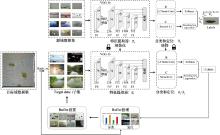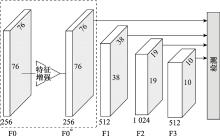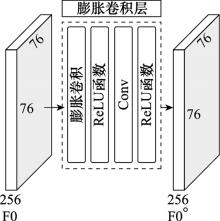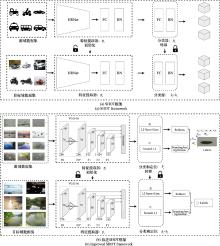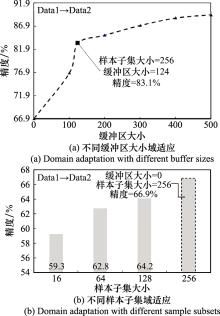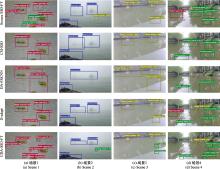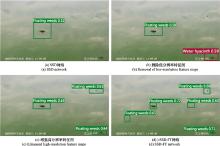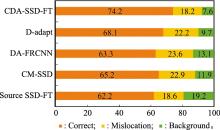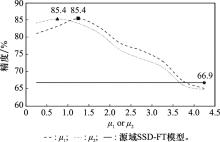Systems Engineering and Electronics ›› 2023, Vol. 45 ›› Issue (11): 3391-3401.doi: 10.12305/j.issn.1001-506X.2023.11.04
• Electronic Technology • Previous Articles Next Articles
A novel detector for floating objects based on continual unsupervised domain adaptation strategy
Renfei CHEN1, Yong PENG1,*, Zhongwen LI2
- 1. Faculty of Infrastructure Engineering, Dalian University of Technology, Dalian 116024, China
2. Institute of Systems Engineering, Dalian University of Technology, Dalian 116024, China
-
Received:2022-10-14Online:2023-10-25Published:2023-10-31 -
Contact:Yong PENG
CLC Number:
Cite this article
Renfei CHEN, Yong PENG, Zhongwen LI. A novel detector for floating objects based on continual unsupervised domain adaptation strategy[J]. Systems Engineering and Electronics, 2023, 45(11): 3391-3401.
share this article
Table 1
Results on quantitative analysis from four scenarios"
| 方法 | 渔船 | 水葫芦 | 漂浮杂草 | 塑料瓶 | mAP/% |
| Data1→Data2 | |||||
| SSD-FT | 63.2 | 72.3 | 65.8 | 66.3 | 66.9 |
| CM-SSD | 73.9 | 78.2 | 76.2 | 69.2 | 74.4 |
| DA-FRCNN | 68.1 | 77.4 | 74.1 | 73.8 | 73.4 |
| D-adapt | 79.8 | 80.3 | 76.3 | 76.4 | 78.2 |
| CDA-SSD-FT | 83.9 | 87.8 | 85.6 | 84.2 | 85.4 |
| Data2→Data3 | |||||
| SSD-FT | 58.3 | 67.5 | 66.8 | 56.3 | 62.2 |
| CM-SSD | 52.2 | 65.2 | 64.2 | 60.2 | 60.5 |
| DA-FRCNN | 63.5 | 68.3 | 70.4 | 66.6 | 67.2 |
| D-adapt | 59.4 | 72.5 | 72.5 | 72.4 | 69.2 |
| CDA-SSD-FT | 79.2 | 78.4 | 82.8 | 79.1 | 79.9 |
| Data3→Data4 | |||||
| SSD-FT | 70.2 | 72.5 | 68.3 | 62.5 | 68.4 |
| CM-SSD | 72.4 | 68.3 | 70.4 | 66.3 | 69.4 |
| DA-FRCNN | 76.9 | 77.2 | 73.9 | 70.5 | 74.6 |
| D-adapt | 71.7 | 75.1 | 76.7 | 72.6 | 74.0 |
| CDA-SSD-FT | 84.9 | 83.1 | 81.3 | 79.4 | 82.2 |
| Data4→Data5 | |||||
| SSD-FT | 72.3 | 69.2 | 73.5 | 69.3 | 71.0 |
| CM-SSD | 68.4 | 70.3 | 72.7 | 71.6 | 70.8 |
| DA-FRCNN | 70.2 | 73.6 | 77.5 | 74.7 | 74.0 |
| D-adapt | 74.9 | 71.7 | 74.2 | 75.9 | 74.2 |
| CDA-SSD-FT | 82.5 | 79.4 | 81.3 | 81.0 | 81.1 |
| 1 |
WANG X , ZHANG M , LIU L , et al. Using EEM-PARAFAC to identify and trace the pollution sources of surface water with receptor models in taihu lake basin, China[J]. Journal of Environmental Management, 2022, 321, 115925.
doi: 10.1016/j.jenvman.2022.115925 |
| 2 |
ZHU Y N , WANG K X , LIN Y X , et al. An online contaminant classification method based on MF-DCCA using conventional water quality indicators[J]. Processes, 2020, 8 (2): 178.
doi: 10.3390/pr8020178 |
| 3 | RUANGPAYOONGSAK N, SUMROENGRIT J, LEANGLUM M. A floating waste scooper robot on water surface[C]// Proc. of the International Conference on Control, Automation and Systems (ICCAS), 2017: 1543-1548. |
| 4 |
GOUTAM M A , RAMESH W U , CHAKRABORTY R , et al. A review on modern and smart technologies for efficient waste disposal and management[J]. Journal of Environmental Management, 2021, 297, 113347.
doi: 10.1016/j.jenvman.2021.113347 |
| 5 | ZHOU Z G , SUN J E , YU J B , et al. An image-based benchmark dataset and a novel object detector for water surface object detection[J]. Frontiers in Neurorobotics, 2021, |
| 6 | REN S Q, HE K M, GIRSHICK R, et al. Faster RCNN: towards real-time object detection with region proposal networks[C]// Proc. of the IEEE International Conference on Neural Information Processing Systems, 2015: 91-99. |
| 7 | REDMON J, DIVVALA S, GIRSHICK R, et al. You only look once: unified, real-time object detection[C]//Proc. of the IEEE Conference on Computer Vision And Pattern Recognition, 2016: 779-788. |
| 8 | LIU W, ANGUELOV D, ERHAN D, et al. SSD: single shot multibox detector[C]//Proc. of the 14th European Conference on Computer Vision, 2016: 21-37. |
| 9 |
CHENG Y , JIANG M , ZHU J , et al. Are we ready for unmanned surface vehicles in inland waterways? The USV in land multisensor dataset and benchmark[J]. IEEE Robotics and Automation Letters, 2021, 6 (2): 3964- 3970.
doi: 10.1109/LRA.2021.3067271 |
| 10 | BAI Y, ZHANG Y, DING M, et al. SOD-MTGAN: small object detection via multi-task generative adversarial network[C]// Proc. of the Computer Vision, 2018: 210-226. |
| 11 | TSUNG Y L, PIOTR D, ROSS G, et al. Feature pyramid networks for object detection[C]//Proc. of the IEEE Conference on Computer Vision and Pattern Recognition, 2017: 2117-2125. |
| 12 | LI J, LIANG X, WEI Y, et al. Perceptual generative adversarial networks for small object detection[C]//Proc. of the IEEE Conference on Computer Vision and Pattern Recognition (CVPR), 2017: 1951-1959. |
| 13 |
LIU Z , LIU J , ZUO X , et al. Multi-scale iterative refinement network for RGB-D salient object detection[J]. Engineering Applications of Artificial Intelligence, 2021, 106, 104473.
doi: 10.1016/j.engappai.2021.104473 |
| 14 | 汪云云, 孙顾威, 赵国祥, 等. 基于自监督知识的无监督新集域适应学习[J]. 软件学报, 2022, 33 (4): 1170- 1182. |
| WANG Y Y , SUN G W , ZHAO G X , et al. Unsupervised new-set domain adaptation with self-supervised knowledge[J]. Journal of Software, 2022, 33 (4): 1170- 1182. | |
| 15 |
LI X , YE M , LIU Y , et al. Adaptive deep convolutional neural networks for scene-specific object detection[J]. IEEE Trans.on Circuits and Systems for Video Technology, 2019, 29 (9): 2538- 2551.
doi: 10.1109/TCSVT.2017.2749620 |
| 16 |
JIA Y , ZHANG J , SHAN S , et al. Unified unsupervised and semi-supervised domain adaptation network for cross-scenario face anti-spoofing[J]. Pattern Recognition, 2021, 115, 107888.
doi: 10.1016/j.patcog.2021.107888 |
| 17 | CHEN Y, LI W, SAKARIDIS C, et al. Domain adaptive faster R-CNN for object detection in the wild[C]//Proc. of the IEEE/CVF Conference on Computer Vision and Pattern Recognition, 2018: 3339-3348. |
| 18 |
JIANG N , FANG J , XU J , et al. SSD based on contour-material level for domain adaptation[J]. Pattern Analysis and Applications, 2021, 24 (3): 1221- 1229.
doi: 10.1007/s10044-021-00986-w |
| 19 |
XIONG L , YE M , ZHANG D , et al. Source data-free domain adaptation for a faster R-CNN[J]. Pattern Recognition, 2022, 124, 108436.
doi: 10.1016/j.patcog.2021.108436 |
| 20 | KIM T, JEONG M, KIM S, et al. Diversify and match: a domain adaptive representation learning paradigm for object detection[C]//Proc. of the IEEE/CVF Conference on Computer Vision and Pattern Recognition (CVPR), 2019: 12448-12457. |
| 21 | 范苍宁, 刘鹏, 肖婷, 等. 深度域适应综述: 一般情况与复杂情况[J]. 自动化学报, 2021, 47 (3): 515- 548. |
| FAN C N , LIU P , XIAO T , et al. A review of deep domain adaptation: general situation and complex situation[J]. Acta Automatica Sinica, 2021, 47 (3): 515- 548. | |
| 22 | TAUFIQUE A M, JAHAN C S, SAVAKIS A E. ConDA: continual unsupervised domain adaptation[EB/OL]. [2022-09-18]. https://arxiv.org/abs/2103.11056. |
| 23 | HOFFMAN J, DARRELL T, SAENKO K. Continuous manifold based adaptation for evolving visual domains[C]//Proc. of the IEEE Conference on Computer Vision and Pattern Recognition, 2014: 867-874. |
| 24 | WULFMEIER M, BEWLEY A, POSNER I. Incremental adversarial domain adaptation for continually changing environments[C]//Proc. of the IEEE International Conference on Robotics and Automation (ICRA), 2018: 4489-4495. |
| 25 | VOLPI R, LARLUS D, ROGEZ G. Continual adaptation of visual representations via domain randomization and meta-learning[C]//Proc. of the IEEE/CVF Conference on Computer Vision and Pattern Recognition (CVPR), 2021: 4441-4451. |
| 26 | LENGA M, SCHULZ H, SAALBACH A. Continual learning for domain adaptation in chest x-ray classification[EB/OL]. [2022-09-18]. https://arxiv.org/abs/2001.05922. |
| 27 |
魏文晓, 刘洁瑜, 沈强, 等. 基于人眼视点图的特征融合小目标检测算法[J]. 系统工程与电子技术, 2022, 44 (4): 1120- 1127.
doi: 10.12305/j.issn.1001-506X.2022.04.07 |
|
WEI W X , LIU J Y , SHEN Q , et al. Feature fusion small target detection algorithm based on human eye view-point map[J]. Systems Engineering and Electronics, 2022, 44 (4): 1120- 1127.
doi: 10.12305/j.issn.1001-506X.2022.04.07 |
|
| 28 | FISHER Y, VLADLEN K. Multi-scale context aggregation by dilated convolutions[EB/OL]. [2022-09-18]. https://arxiv.org/arXiv:1511.07122. |
| 29 | LIANG J, HU D, FENG J. Do we really need to access the source data? source hypothesis transfer for unsupervised domain adaptation[EB/OL]. [2022-09-18]. https://arxiv.org/abs/2002.08546. |
| 30 | ANDREAS K, PIETRO P, RYAN G. Discriminative clustering by regularized information maximization[C]//Proc. of the 23rd International Conference on Neural Information Processing Systems, 2010: 775-783. |
| 31 | HU W, MIYATO T, TOKUI S, et al. Learning discrete representations via information maximizing self-augmented training[C]// Proc. of the 34th International Conference on Machine Learning, 2017: 1558-1567. |
| 32 | JIANG J, CHEN B, WANG J, et al. Decoupled adaptation for cross-domain object detection[EB/OL]. [2022-09-18]. https://arxiv.org/abs/2110.02578. |
| [1] | Meng WANG, Bing ZHU. Application of uncertainty modeling in 2D and 3D object detection [J]. Systems Engineering and Electronics, 2023, 45(8): 2370-2376. |
| [2] | Kai SHAO, Ziqun DU, Guangyu WANG. CSI feedback method for dynamically adjusting compression rate based on model pruning [J]. Systems Engineering and Electronics, 2023, 45(8): 2615-2622. |
| [3] | Tianshu CUI, Dong WANG, Zhen HUANG. Automatic modulation classification based on lightweight network for space cognitive communication [J]. Systems Engineering and Electronics, 2023, 45(7): 2220-2226. |
| [4] | Daozhi WEI, Zhaoyu ZHANG, Jiahao XIE, Ning LI. Multi-sensor cross cueing technique based on improved Actor-Critic algorithm [J]. Systems Engineering and Electronics, 2023, 45(6): 1624-1632. |
| [5] | Yu JIANG, Qi YUAN, Zhitao HU, Weiwei WU, Xin GU. Airport arrival and departure delay time prediction based on meteorological factors [J]. Systems Engineering and Electronics, 2023, 45(6): 1722-1731. |
| [6] | Yang CHEN, Canhui LIAO, Kun ZHANG, Jian LIU, Pengju WANG. A signal modulation indentification algorithm based on self-supervised contrast learning [J]. Systems Engineering and Electronics, 2023, 45(4): 1200-1206. |
| [7] | Ye ZHANG, Yi HOU, Kewei OUYANG, Shilin ZHOU. Survey of univariate sequence data classification methods [J]. Systems Engineering and Electronics, 2023, 45(2): 313-335. |
| [8] | Zhengtu SHAO, Dengrong XU, Wenli XU, Hanzhong WANG. Radar active jamming recognition based on LSTM and residual network [J]. Systems Engineering and Electronics, 2023, 45(2): 416-423. |
| [9] | Chensong TAO, Siwei CHEN, Shunping XIAO. SAR image interrupted sampling repeater jamming detection based on deep learning models [J]. Systems Engineering and Electronics, 2023, 45(11): 3465-3473. |
| [10] | Shiyang HE, Ling WANG, Daiyin ZHU, Jun QIAN. Thunderstorm prediction method based on spatiotemporal memory decoupling RNN [J]. Systems Engineering and Electronics, 2023, 45(11): 3474-3480. |
| [11] | Haoran LI, Wei XIONG, Yaqi CUI. An association method between SAR images and AIS information based on depth feature fusion [J]. Systems Engineering and Electronics, 2023, 45(11): 3491-3497. |
| [12] | Zichao LIU, Jiang WANG, Shaoming HE. Time and angle control guidance law based on deep learning [J]. Systems Engineering and Electronics, 2023, 45(11): 3579-3587. |
| [13] | Ce JI, Bohan SONG, Rong GENG, Minjun LIANG. Deep learning based channel estimation for OFDM systems in fast time-varying channel [J]. Systems Engineering and Electronics, 2023, 45(11): 3649-3655. |
| [14] | Jianli DING, Qiqi ZHANG, Jing WANG, Weigang HUO. ADS-B anomaly detection method based on Transformer-VAE [J]. Systems Engineering and Electronics, 2023, 45(11): 3680-3689. |
| [15] | Ting SONG, Zezhao WU, Ai GAO, Jianping YUAN. CycleGAN-based data enhancement method for lunar surface images [J]. Systems Engineering and Electronics, 2023, 45(10): 3041-3048. |
| Viewed | ||||||
|
Full text |
|
|||||
|
Abstract |
|
|||||
